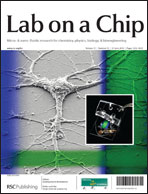Microdevice to capture colon crypts for in vitro studies†
Abstract
There is a need in biological research for tools designed to manipulate the environment surrounding microscopic regions of tissue. In the current work, a device for the oriented capture of an important and under-studied tissue, the colon crypt, has been designed and tested. The objective of this work is to create a BioMEMs device for biological assays of living colonic crypts. The end goal will be to subject the polarized tissue to user-controlled fluidic microenvironments in a manner that recapitulates the in vivo state. Crypt surrogates, polymeric structures of similar dimensions and shape to isolated colon crypts, were used in the initial design and testing of the device. Successful capture of crypt surrogates was accomplished on a simple device composed of an array of micron-scale capture sites that enabled individual structures to be captured with high efficiency (92 ± 3%) in an ordered and properly oriented fashion. The device was then evaluated using colon crypts isolated from a murine animal model. The capture efficiency attained using the fixed biologic sample was 37 ± 5% due to the increased variability of the colon crypts compared with the surrogate structures, yet 94 ± 3% of the captured crypts were properly oriented. A simple approach to plug the remaining capture sites in the array was performed using inert glass beads. Blockage of unfilled capture sites is an important feature to establish a chemical gradient across the arrayed crypts. A chemical concentration gradient (Cluminal/


 Please wait while we load your content...
Please wait while we load your content...